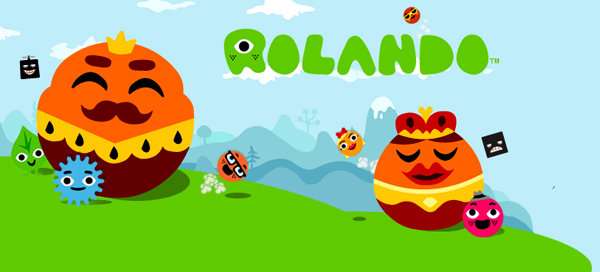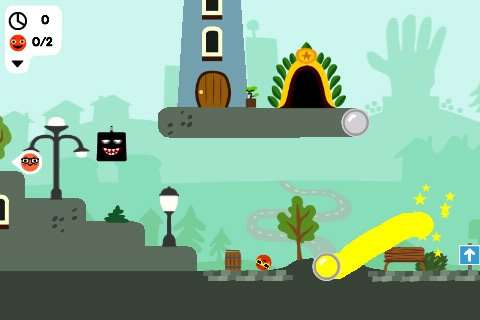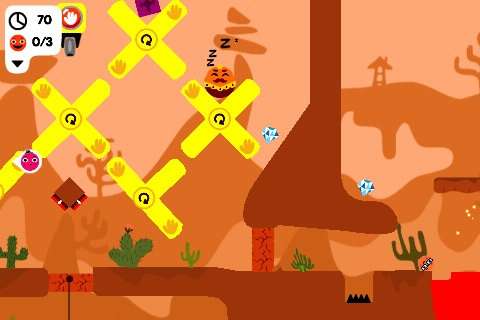Rolando iPhone, iPod Touch Review

Although iPhone games are generally of a high standard when viewed alongside titles available on other mobile phones, they often fare less well when compared to software on specialist handheld gaming platforms like the DS and PSP.
This could be attributed to the low price points on Apple’s App Store and to the fact that developers have yet to get to grips with how to make the best use of the iPhone’s unique capabilities.
The hardware itself is certainly no barrier to quality, with a screen that’s bigger than that of the DS, and has a better resolution than that of the PSP. Also, according to programming genius John Carmack, the iPhone is “more powerful than a DS and PSP combined.”
It’s a relief then that one company have taken the tools at their disposal and created a game that is worthy of standing shoulder-to-shoulder with those on Nintendo and Sony’s rival products.

When looking at Rolando the first game that springs to mind is undoubtedly LocoRoco, but while the two titles share some superficial similarities it doesn’t take long to realise that the gameplay is quite different.
Rolando does share the visual style of LocoRoco – brightly coloured, flat, plain-textured objects. It also has similar catchy upbeat tunes, in this case the jazzy melodies are provided by British break-beat DJ, Mr. Scruff.
The two games also both task the player with rolling small creatures through a level to the exit, but whereas LocoRoco had gamers shifting the ground itself, Rolando allows control over the individual ‘Rolandos’. Here, the iPhone one-ups Sony’s PSP by giving us the intuitive tilt control that LocoRoco was practically crying out for.
Of course, the iPhone also has a touch screen and the use of this is implemented superbly. You can simply tap a Rolando to select it, or drag a box over a group of Rolandos to select them all at once. Also using the iPhone’s multi-touch abilities you can use two fingers at once to drag the camera around the level, and any off-screen Rolandos can be quickly selected with a tap of their icon at the edge of the screen.
A Rolando’s only skill besides rolling is jumping, which is performed with a simple upward flick of the finger. All of these touch gestures can be performed very quickly after a slight bit of practice, thus removing the issue that other iPhone games have had whereby the players own fingers obscure the gameplay. The controls generally perform admirably, but you’ll no doubt experience a few infrequent occasions when your intentions are misinterpreted.
Finger (as the Rolandos have adorably named the player) can also control various contraptions throughout the levels, including lifts, drawbridges, catapults and bomb dispensers. The fact that the characters directly address the player, and that the touch-controlled gizmos give you a direct physical link with the colourful levels really helps to involve and immerse you in the world of Rolando.
The game also mixes up the challenge by introducing new characters both controllable and otherwise. Royal Spikey Commandos have the handy ability of being able to stick to walls and ceilings, and once you get the hang of the tilt-controls being reversed when they’re upside-down they become probably your most useful asset.
The uncontrollable Rolandos are both members of the Rolando Royal Family. The voluminous King is perhaps modelled after Henry VIII, being a fat, rotund lazy monarch whose sleeping form must be pushed around by his regular Rolando subjects.
His son, the Prince, certainly doesn’t take after his father. In fact, he can’t stop moving. The Prince will roll constantly in one direction until he hits an obstacle, whereby he will turn around and continue to roll in the opposite direction.
The Royals are your first priority, and must be brought to safety at the end of the level before any of your regular Rolandos can escape. As you can imagine, having to shepherd these lazy/excitable nobles provides much of the challenge on certain stages.
There are a total of 36 of these stages, spread over four visually distinct lands. As well as simple progression each level has three possible medals up for grabs. These are for saving all Rolandos on that level, beating that level’s challenge time and for collecting all diamonds scattered about that level.

These optional challenges provide a healthy amount of replay value, and if you’re anything like me, you’ll refuse to move onto the next level until you’ve achieved everything on the current one. Speaking of which, Rolando also features a selection of 360-style achievements and even a nifty ‘achievement unlocked’ notice that pops up when the requirements are met.
Rolando also includes features that are mindful that that platform it’s being played on is still an iPod/mobile phone. Pleasingly, it includes support for listening to your own music whilst playing, something that strangely isn’t a standard feature on iPod Touch/iPhone games yet.
But the best feature has to be the innovative iSave function. If you get a phone call, or tap the Home button to go and do something else, your progress is instantly frozen and you can resume from that exact point when you next play. The Rolando icon on your Home screen will even display the number of Rolandos that are currently suspended in limbo, subtly beckoning you to pick up and play once again.

Rolando is undoubtedly the best iPhone game yet, and at £5.99 is a complete bargain. It could easily be sold for three times that much on another handheld console and no-one would bat an eyelid. The gameplay is challenging and enjoyable, the controls take great advantage of the platform’s unique capabilities, and the presentation is second-to-none. Features like iSave will hopefully become ubiquitous across iPhone games, and Rolando has raised the bar in terms of quality original gaming available on the App Store.
Rolando was released a little too late in the year to make it onto any “Game of The Year” lists, but hopefully we’ll be seeing more of the cute little spheres in 2009.


